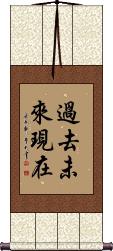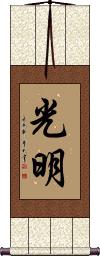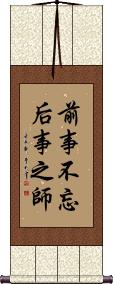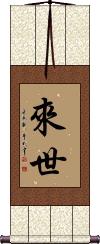Many custom options...
And formats...

Future in Chinese / Japanese...
Buy a Future calligraphy wall scroll here!
Personalize your custom “Future” project by clicking the button next to your favorite “Future” title below...
1. Bright and Promising Future
4. Light / Bright and Promising Future
Bright and Promising Future
明るい未来 is a Japanese proverb that means “Bright Future.”
It suggests a lot of possibilities and potential awaits in your future. A great gift for a graduate.
The first part of this proverb literally means bright or light. The second part means the future but can also be translated as “the world to come.”
Note: Because this selection contains some special Japanese Hiragana characters, it should be written by a Japanese calligrapher.
Past Future and Present
A Bright Future
Incredible 10,000-Mile Flight of the Peng
鵬程萬里 is an ancient Chinese proverb used in modern times to wish someone a long and successful career.
It's really about the 10,000 Flight of the Peng (Peng, also known as Roc is a mythical fish that can turn into a bird and take flight).
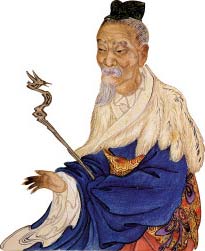
莊子
Zhuangzi or Chuang Tzu
Breaking down each character:
1. Peng or Roc (a kind of bird).
2. Journey (in this case, a flight).
3. 10,000 (Ten Thousand).
4. Li is a unit of distance often referred to as a “Chinese Mile,” though the real distance is about half a kilometer.
Direct Translation: “Peng's Journey [of] 10,000 Li.”
Literal meaning: “The 10,000-Li Flying Range Of The Roc.”
Perceived meaning: “To have a bright future” or “To go far.”
This proverb/idiom comes from the book of Zhuangzi or Chuang Tzu. It tells the tale of a huge fish that could turn into a gigantic bird. This bird was called a “peng” and was many miles long. This legendary size allowed the Peng to fly from the Northern Sea to the Southern Sea in a single bound.
Wishing someone “a Peng's Journey of 10,000 Li” will imply that they can travel far without stopping and will have great success, a long career, and a prosperous future.
Light / Bright and Promising Future
光明 is a nice way to say “light” in Chinese and old Korean Hanja.
This is because the word also suggests a bright future or refers to someone who is very promising (great future potential).
The first character means light or bright.
The second character means bright and clear (in this context).
This word appears in most Japanese dictionaries, but it is not the most common Japanese Kanji word for light (more commonly used for the name Mitsuharu).
In old Korean Hanja, this can also mean brightness or brilliance.
In the context of Buddhism, this means “Light emanating from a Buddha or Bodhisattva, symbolizing their wisdom and compassion.”
Past experience is the teacher for the future
Past events not forgotten serve as teachers for later events.
The most literal translation to English of this ancient 前事不忘后事之师 Chinese proverb is:
“Past events not forgotten serve as teachers for later events.”
However, it's been translated several ways:
Don't forget past events, they can guide you in the future.
Benefit from past experience.
Past experience, if not forgotten, is a guide for the future.
Past calamity is my teacher.
A good memory for the past is a teacher for the future.
The remembrance of the past is the teacher of the future.
If one remembers the lessons of the past; They will serve as a guide to avoid mistakes in the future.
The origin:
This proverb comes from the 5th century B.C., just before the Warring States Period in the territory now known as China.
The head of the State of Jin, Zhi Bo, seized power in a coup. He did this with help from the armies of the State of Han and Wei. Instead of being grateful for the help from Han and Wei, he treacherously took the land of Han and Wei. Never satisfied, Zhi Bo employed the armies of Han and Wei to attack and seize the State of Zhao.
The king of Zhao took advice from his minister Zhang Mengtan and secretly contacted the Han and Wei armies to reverse their plans and attack the army of Zhi Bo instead. The plan was successful, and the State of Zhao was not only saved but was set to become a powerful kingdom in the region.
Zhang Mengtan immediately submitted his resignation to a confused king of Zhao. When asked why, Zhang Mengtan said, “I've done my duty to save my kingdom, but looking back at past experience, I know sovereign kings are never satisfied with the power or land at hand. They will join others and fight for more power and more land. I must learn from past experiences, as those experiences are the teachers of future events.”
The king could not dispute the logic in that statement and accepted Zhang Mengtan's resignation.
For generations, the State of Zhao continued to fight for power and land until finally defeated and decimated by the State of Qin (which led to the birth of the Qin Dynasty in 221 B.C.).
Eternal Life / Future Life
來世 is a word that can be used in many different ways.
It is often used to express the next life (life in heaven or wherever your soul is bound for). So it does have a religious overtone. However, it can also be used to express your life in the future - perhaps during your present lifetime.
It can also be translated as “the next world,” “the next generation,” “the time that is to come,” “otherworld,” or simply “posterity.”
See Also: Eternity | Rebirth | Reincarnation | Immortality
These search terms might be related to Future:
Big Dream / Great Hope
Crisis Equals Danger Plus Opportunity?
Faith Hope Love
Fate / Opportunity / Chance
Great Expectations
Hope
Opportunity
Opportunity / Good Luck
Opportunity Knocks Only Once
Potential / Momentum
Not the results for future that you were looking for?
Below are some entries from our dictionary that may match your future search...
| Characters If shown, 2nd row is Simp. Chinese |
Pronunciation Romanization |
Simple Dictionary Definition |
來 来 see styles |
lái lai2 lai rai らい |
More info & calligraphy: To Come / To Arrive(female given name) Rai āgama; āgam-; āgata. Come, the coming, future. |
業 业 see styles |
yè ye4 yeh hajime はじめ |
More info & calligraphy: Karmadeed; act; work; performance; (personal name) Hajime karman, karma, "action, work, deed"; "moral duty"; "product, result, effect." M.W. The doctrine of the act; deeds and their effects on the character, especially in their relation to succeeding forms of transmigration. The 三業 are thought, word, and deed, each as good, bad, or indifferent. Karma from former lives is 宿業, from present conduct 現業. Karma is moral action that causes future retribution, and either good or evil transmigration. It is also that moral kernel in which each being survives death for further rebirth or metempsychosis. There are categories of 2, 3, 4, 6, and 10; the 六業 are rebirth in the hells, or as animals, hungry ghosts, men, devas, or asuras: v. 六趣. |
來世 来世 see styles |
lái shì lai2 shi4 lai shih raise |
More info & calligraphy: Eternal Life / Future LifeFuture world, or rebirth. |
傳承 传承 see styles |
chuán chéng chuan2 cheng2 ch`uan ch`eng chuan cheng |
More info & calligraphy: Smriti |
光明 see styles |
guāng míng guang1 ming2 kuang ming kanmyon クァンミョン |
More info & calligraphy: Light / Bright and Promising Future(1) bright light; (2) hope; bright future; (3) {Buddh} light emanating from a buddha or bodhisattva, symbolizing their wisdom and compassion; (place-name) Gwangmyeong (South Korea) v. last entry. |
明日 see styles |
míng rì ming2 ri4 ming jih meibi / mebi めいび |
More info & calligraphy: Tomorrow / The Next Sun(n,adv) (1) tomorrow; (n,adv) (2) (あす only) near future; (female given name) Meibi tomorrow |
超人 see styles |
chāo rén chao1 ren2 ch`ao jen chao jen choujin / chojin ちょうじん |
More info & calligraphy: Superman(1) superman; superwoman; (2) {phil} (ant: 末人) Ubermensch (Nietzsche's ideal man of the future); overman |
溫故知新 温故知新 see styles |
wēn gù zhī xīn wen1 gu4 zhi1 xin1 wen ku chih hsin |
More info & calligraphy: Learn New Ways From Old / OnkochishinSee: 温故知新 |
鵬程萬里 鹏程万里 see styles |
péng chéng wàn lǐ peng2 cheng2 wan4 li3 p`eng ch`eng wan li peng cheng wan li |
More info & calligraphy: A Bright Future |
過去未來現在 过去未来现在 see styles |
guō qù wèi lái xiàn zài guo1 qu4 wei4 lai2 xian4 zai4 kuo ch`ü wei lai hsien tsai kuo chü wei lai hsien tsai kako mirai genzai |
More info & calligraphy: Past Future and Present |
使 see styles |
shǐ shi3 shih tsukasa つかさ |
to make; to cause; to enable; to use; to employ; to send; to instruct sb to do something; envoy; messenger (1) messenger; (2) (abbreviation) (See 検非違使) police and judicial chief (Heian and Kamakura periods); (3) {Buddh} (See 煩悩・2) klesha (polluting thoughts such as greed, hatred and delusion, which result in suffering); (female given name) Tsukasa To send; cause; a messenger; a pursuer, molester, lictor, disturber, troubler, intp. as 煩惱 kleśa, affliction, distress, worldly cares, vexations, and as consequent reincarnation. There are categories of 10, 16, 98, 112, and 128 such troublers, e. g. desire, hate, stupor, pride, doubt, erroneous views, etc., leading to painful results in future rebirths, for they are karma-messengers executing its purpose. Also 金剛童子 q. v. |
前 see styles |
qián qian2 ch`ien chien misaki みさき |
front; forward; ahead; first; top (followed by a number); future; ago; before; BC (e.g. 前293年); former; formerly (1) in front (of); before (e.g. a building); (n,adj-no,adv) (2) before; earlier; previously; prior; ago; (minutes) to (the hour); (noun - becomes adjective with の) (3) (the) front; frontal part; fore; head (e.g. of a line); (4) forward; ahead; (5) (in the) presence (of); in front (of someone); (can be adjective with の) (6) previous (e.g. page); prior (e.g. engagement); first (e.g. half); former (e.g. example); (suffix) (7) (after a noun or the -masu stem of a verb) (See 一人前・1) portion; helping; (8) front (of one's body or clothing); breast (of a coat, kimono, etc.); (9) privates; private parts; (10) (colloquialism) criminal record; previous conviction; (a) prior; (personal name) Misaki pūrva. Before; former, previous; in front. |
劫 see styles |
jié jie2 chieh kou; gou; kou / ko; go; ko こう; ごう; コウ |
to rob; to plunder; to seize by force; to coerce; calamity; abbr. for kalpa 劫波[jie2 bo1] (1) (こう, ごう only) {Buddh} kalpa (eon, aeon); (2) (kana only) {go} (usu. コウ) ko; position that allows for eternal capture and recapture of the same stones 刧 A kalpa, aeon, age; also translit. ka; 'a fabulous period of time, a day of Brahmā or 1, 000 Yugas, a period of four hundred and thirty-two million years of mortals, measuring the duration of the world; (a month of Brahmā is supposed to contain thirty such kalpas; according to the Mahābhārata twelve months of Brahmā constitute his year, and one hundred such years his lifetime; fifty years of Brahmā are supposed to have elapsed... ).' M. W. An aeon of incalculable time, therefore called a 大時節 great time-node. v. 劫波.; The three asaṃkhyeya kalpas, the three countless aeons, the period of a bodhisattva's development; also the past 莊嚴劫, the present 賢劫, and the future 星宿劫 kalpas. There are other groups. 三劫三千佛 The thousand Buddhas in each of the three kalpas. |
彖 see styles |
tuàn tuan4 t`uan tuan |
to foretell the future using the trigrams of the Book of Changes 易經|易经 |
往 see styles |
wǎng wang3 wang nobori のぼり |
to go (in a direction); to; towards; (of a train) bound for; past; previous (personal name) Nobori To go; gone, past; to be going to, future. |
有 see styles |
yǒu you3 yu yumi ゆみ |
to have; there is; (bound form) having; with; -ful; -ed; -al (as in 有意[you3 yi4] intentional) (1) existence; (n,n-pref) (2) possession; having; (3) (abbreviation) (in company names; written as (有)) (See 有限会社) limited company; (personal name) Yumi bhāva: that which exists, the existing, existence; to have, possess, be. It is defined as (1) the opposite of 無 wu and 空 kong the non-existent; (2) one of the twelve nidānas, existence; the condition which, considered as cause, produces effect; (3) effect, the consequence of cause; (4) anything that can be relied upon in the visible or invisible realm. It means any state which lies between birth and death, or beginning and end. There are numerous categories— 3, 4, 7, 9, 18, 25, and 29. The 三有 are the 三界 trailokya, i. e. 欲, 色 and 無色界 the realms of desire, of form, and of non-form, all of them realms of mortality; another three are 本有 the present body and mind, or existence, 當有 the future ditto, 中有 the intermediate ditto. Other definitions give the different forms or modes of existence. |
未 see styles |
wèi wei4 wei mirei / mire みれい |
not yet; did not; have not; not; 8th earthly branch: 1-3 p.m., 6th solar month (7th July-6th August), year of the Sheep; ancient Chinese compass point: 210° (prefix) not yet; un-; (female given name) Mirei Not yet; the future; 1-3 p. m. |
當 当 see styles |
dàng dang4 tang atari あたり |
at or in the very same...; suitable; adequate; fitting; proper; to replace; to regard as; to think; to pawn; (coll.) to fail (a student) (surname) Atari Suitable, adequate, equal to; to bear, undertake; ought; proper; to regard as, as; to pawn, put in place of; at, in the future. |
碑 see styles |
bēi bei1 pei ishibumi いしぶみ |
a monument; an upright stone tablet; stele; CL:塊|块[kuai4],面[mian4] stone monument bearing an inscription (esp. memorial for future generations); stele; stela; (surname) Ishibumi A stone tablet, or monument. |
お先 see styles |
osaki おさき |
going before; the future |
三世 see styles |
sān shì san1 shi4 san shih miyo みよ |
the Third (of numbered kings) (1) {Buddh} three temporal states of existence; past, present and future; (2) (さんぜ only) three generations; (female given name) Miyo The three periods, 過去, 現在, 未來or 過, 現, 未, past, present, and future. The universe is described as eternally in motion, like flowing stream. Also 未生, 巳生,後滅, or 未, 現, 過 unborn, born, dead The 華嚴經 Hua-yen sūtra has a division of ten kinds of past, present, and future i.e. the past spoken of as past, present, and future, the present spoken of in like manner, the future also, with the addition of the present as the three periods in one instant. Also 三際. |
三明 see styles |
sān míng san1 ming2 san ming mitsuaki みつあき |
see 三明市[San1 ming2 Shi4] {Buddh} (See 宿命通,天眼通,漏尽通) three kinds of awareness; (surname, given name) Mitsuaki The three insights; also 三達. Applied to Buddhas they are called 三達, to arhats 三明. (a) 宿命明 Insight into the mortal conditions of self and others in previous lives; (b) 天眼明 supernatural insight into future mortal conditions; (c) 漏盡明 nirvāṇa insight, i.e. into present mortal sufferings so as to overcome aIl passions or temptations. In the 倶舍論 27 the three are termed 住智識證明; 死生識證明 and 漏盡識證明. For 三明經 v. 長阿含16. |
三智 see styles |
sān zhì san1 zhi4 san chih michi みち |
(female given name) Michi The three kinds of wisdom: (1) (a) 一切智 śrāvaka and pratyeka-buddha knowledge that all the dharma or laws are 空 void and unreal; (b) 道種智 bodhisattva-knowledge. of all things in their proper discrimination; (c) 一切種智 Buddha-knowledge, or perfect knowledge of all things in their every aspect and relationship past, present, and future. Tiantai associates the above with 室, 候, 中. (2) (a) 世間智 earthly or ordinary wisdom; (b) 出世間智 supra-mundane, or spiritual (śrāvaka and pratyeka-buddha) wisdom; (c) 出世間上上智 supreme wisdom of bodhisattvas and Buddhas. v. 智度論 27, 止觀 3, and 概伽經 3. Cf. — 心三智. |
三有 see styles |
sān yǒu san1 you3 san yu san'u |
The three kinds of bhava, or existence; idem 三界 q. v. The three states of mortal existence in the trailokya, i. e. in the realms of desire, of form, and beyond form. Another definition is 現有 present existence, or the present body and mind; 當有 in a future state; 中有 antara-bhava, in the intermediate state. 三有對 The three sets of limitation on freedom: (a) direct resistance or opposition; (b) environment or condition; (c) attachment. 三有爲法 The three active) functioning dharmas: (1) pratigha, matter or form, i. e. that which has ' substantial resistance'; (2) mind; and (3) 非色非心 entities neither of matter nor mind; cf. 七十五法. 三有爲相 The three forms of all phenomena, birth, stay (i. e. 1ife), death; utpāda, sthiti, and nirvana. |
三生 see styles |
sān shēng san1 sheng1 san sheng mitsuo みつお |
(surname, given name) Mitsuo The three births, or reincarnations, past, present, future. Tiantai has (a) 種 planting the seed; (b) 熟 ripening; (c) 脫 liberating, stripping, or harvesting, i.e. beginning, development, and reward of bodhi, a process either gradual or instantaneous. Huayan has (a) 見聞生 a past life of seeing and hearing Buddha-truth; (b) 解行生 liberation in the present life; (c) 證入生 realization of life in Buddhahood. This is also called 三生成佛, Buddhahood in the course of three lives. There is also a definition of three rebirths as the shortest term for arhatship, sixty kalpas being the longest. There are other definitions. |
三界 see styles |
sān jiè san1 jie4 san chieh mikai みかい |
(1) {Buddh} (See 欲界,色界,無色界) the three realms of existence; (2) (abbreviation) {Buddh} (See 三千大千世界) the whole universe (of a billion worlds) that Buddha enlightened; (3) {Buddh} (See 三世・さんぜ・1) past, present and future existences; (suffix) (4) far-off ...; distant ...; (surname) Mikai Trailokya or Triloka; the three realms; also 三有. It is the Buddhist metaphysical equivalent for the Brahmanic cosmological bhuvanatraya, or triple world of bhūr, bhuvaḥ, and svar, earth, atmosphere, and heaven. The Buddhist three are 欲, 色, and 無色界, i.e. world of sensuous desire, form, and formless world of pure spirit. (a) 欲界 Kāmadhātu is the realm of sensuous desire, of 婬 and 食 sex and food; it includes the six heavens of desire, the human world, and the hells. (b) 色界 Rūpadhātu is the realm of form, meaning 質礙 that which is substantial and resistant: it is above the lust-world and contains (so to speak) bodies, palaces, things, all mystic and wonderful一a semi-material conception like that in Revelation; it is represented in the 四禪天, or Brahmalokas. (c) 無色界 Arūpadhātu, or ārūpyadhātu, is the formless realm of pure spirit, where there are no bodies, places, things, at any rate none to which human terms would apply, but where the mind dwells in mystic contemplation; its extent is indefinable, but it is, conceived of in four stages, i,e. 四空處 the four "empty" regions, or regions of space in the immaterial world, which are 四無色 the four "formless" realms, or realms beyond form; being above the realm of form, their bounds cannot be defined. v. 倶舍論世間品. |
三節 三节 see styles |
sān jié san1 jie2 san chieh sansetsu |
The three divisions of the 十二因緣 twelve nidānas, q.v.: (a) past, i.e. the first two; (b) present— the next eight; (c) future— the last two. |
三達 三达 see styles |
sān dá san1 da2 san ta mitatsu みたつ |
(surname) Mitatsu Three aspects of the omniscience of Buddha: knowledge of future karma, of past karma, of present illusion and liberation; v. 三明. |
三際 三际 see styles |
sān jì san1 ji4 san chi sanzai |
Past, present, future, idem 三世. |
下世 see styles |
xià shì xia4 shi4 hsia shih shimoyo しもよ |
to die; future incarnation; next life; to be born; to come into the world; future generation (surname) Shimoyo |
Click here for more future results from our dictionary
The following table may be helpful for those studying Chinese or Japanese...
| Title | Characters | Romaji (Romanized Japanese) | Various forms of Romanized Chinese | |
| Bright and Promising Future | 明るい未来 | akarui mirai akaruimirai | ||
| Past Future and Present | 過去未來現在 过去未来现在 | kako mirai genzai kakomiraigenzai | guō qù wèi lái xiàn zài guo1 qu4 wei4 lai2 xian4 zai4 guo qu wei lai xian zai guoquweilaixianzai | kuo ch`ü wei lai hsien tsai kuochüweilaihsientsai kuo chü wei lai hsien tsai |
| A Bright Future | 鵬程萬里 鹏程万里 | péng chéng wàn lǐ peng2 cheng2 wan4 li3 peng cheng wan li pengchengwanli | p`eng ch`eng wan li pengchengwanli peng cheng wan li |
|
| Light Bright and Promising Future | 光明 | kou mei / mitsu haru koumei / mitsuharu ko mei / mitsu haru | guāng míng guang1 ming2 guang ming guangming | kuang ming kuangming |
| Past experience is the teacher for the future | 前事不忘后事之師 前事不忘后事之师 | qián shì bú wàng hòu shí zhī shī qian2 shi4 bu2 wang4 hou4 shi2 zhi1 shi1 qian shi bu wang hou shi zhi shi | ch`ien shih pu wang hou shih chih shih chien shih pu wang hou shih chih shih |
|
| Eternal Life Future Life | 來世 来世 | rai-se | lái shì / lai2 shi4 / lai shi / laishi | lai shih / laishih |
| In some entries above you will see that characters have different versions above and below a line. In these cases, the characters above the line are Traditional Chinese, while the ones below are Simplified Chinese. | ||||
Successful Chinese Character and Japanese Kanji calligraphy searches within the last few hours...

